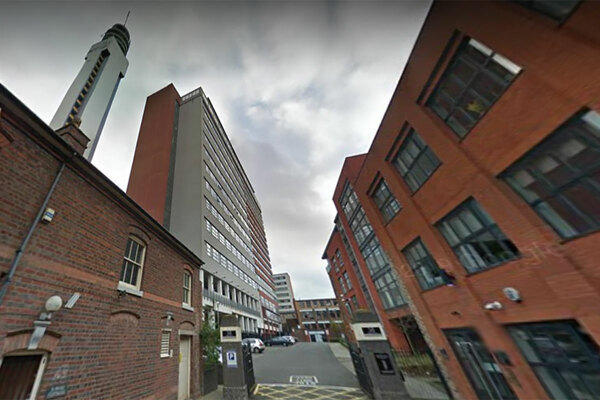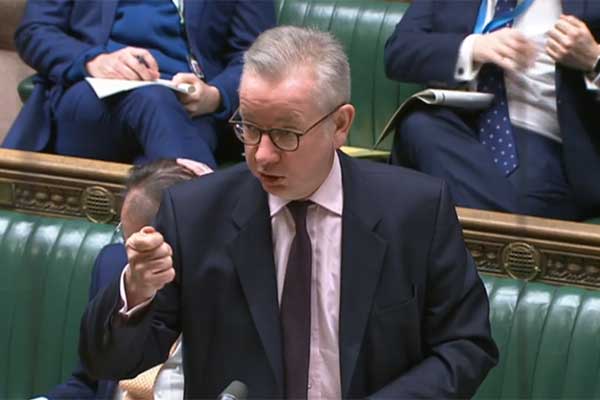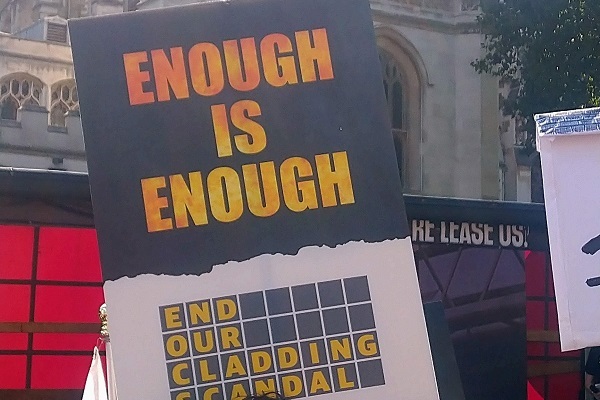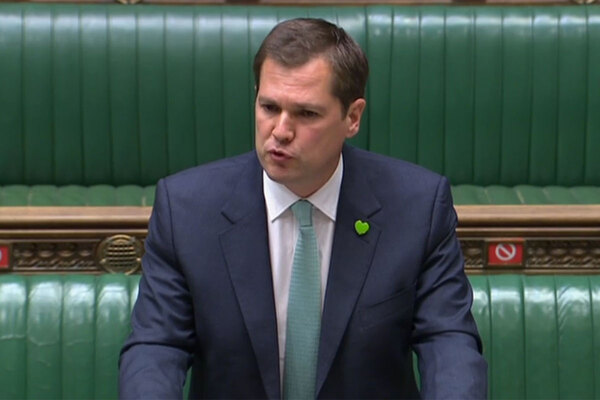You are viewing 1 of your 1 free articles
Gove’s building safety plan: the full rundown of what he will say in his speech
The housing secretary will set out his proposals for how he intends to fix the building safety crisis later today. In what is being billed as the biggest intervention to the crisis – which has been going on since the Grenfell tragedy – many leaseholders will be hoping it can end their misery. Jack Simpson gives a rundown of what we can expect from the speech
Later today, Michael Gove will stand in front of parliament and deliver his plan to fix the building safety crisis once and for all and protect tens of thousands of leaseholders from crippling remediation costs.
More than four-and-a-half years since the Grenfell Tower fire killed 72 people, Mr Gove will say that the Building Safety Programme remains broken and that it should be the industries responsible for causing the problems that should shoulder the costs, not blameless leaseholders.
So, should leaseholders feel hopeful?
Four housing secretaries have gone before Mr Gove, all with their plans to fix the building safety crisis, and all have left residents caught up in the crisis disappointed.
But this feels different. For the first time, Mr Gove will today clearly state that “no leaseholder living in a building above 11 metres will ever face the costs for fixing dangerous cladding”.
And to achieve this, he has some wide-reaching proposals.
As part of his plans, Mr Gove will clearly set the government’s position that it is the developers, contractors and manufacturers that are responsible for the problem and must pay.
At the heart of this will be a new £4bn fund to protect leaseholders living in blocks between 11 and 18 metres tall, and Mr Gove will expect developers to pick up this tab.
The government will also take a more proactive approach in trying to recoup costs of the companies that it feels are responsible for issues, with a new central taskforce whose sole purpose will be to expose and pursue developers that have mis-sold products or cut corners in construction.
Controversial guidance like the Consolidated Advice Note, which has dragged tens of thousands of buildings into the building safety crisis, will be replaced, and Mr Gove hopes that a new proportional approach to building safety assessments will develop.
And he will not take further legislative action off the table either. He is threatening to impose new legislation on developers if they are unwilling to contribute more.
Things could reach a head in the coming weeks, with the government planning showdown talks with the construction sector and leaseholders, to thrash out a way forward.
Inside Housing has now seen the draft speech and can give the most comprehensive rundown so far of what will be in it and what the proposals will mean for leaseholders and the housing sector.
The £4bn plan to protect leaseholders
Mr Gove will say today that it is now the government’s position that no leaseholder living in a building above 11 metres tall should have to pay a penny towards cladding removal.
Key to this is his plan to raise £4bn to cover the cost of remediating buildings between 11 and 18 metres.
Previously, the government planned to help these leaseholders through a loan scheme that would see the work paid for upfront, and then leaseholders pay back the loan at a maximum of £50 a month.
The plan put forward by the former housing secretary was controversial and would still have innocent leaseholders on the hook for tens of thousands of pounds.
With that in mind, Gove has unceremoniously binned the plan.
Instead, he wants to raise £4bn to put towards a grant scheme that would completely absolve these leaseholders from costs. But how would it be funded?
On Friday, BBC Newsnight’s Lewis Goodall published a letter from the Treasury (see below) which stated that it would not be providing any more government funds above what has already given to remove dangerous cladding.
Currently funding for building safety stands at £5.1bn, with £2bn expected to be recouped from developers over the next decade.
SCOOP: Michael Gove to announce dangerous cladding policy changes next week- letter from Treasury to DLUHC confirms:
— Lewis Goodall (@lewis_goodall)
-leaseholders in buildings 11-18m spared cladding costs
-Gove to try to make developers pay £4bn but no new public money
-And this will cover cladding only. pic.twitter.com/rUitzjqa8dSCOOP: Michael Gove to announce dangerous cladding policy changes next week- letter from Treasury to DLUHC confirms:
— Lewis Goodall (@lewis_goodall) January 7, 2022
-leaseholders in buildings 11-18m spared cladding costs
-Gove to try to make developers pay £4bn but no new public money
-And this will cover cladding only. pic.twitter.com/rUitzjqa8d
So, Mr Gove has looked to the construction industry to pay for it. In a letter sent today to developers, he has called for a new deal with the industry to make financial contributions to this fund.
And if they don’t? The housing secretary has threatened to pursue them through legal actions, and restrict their access to public contracts or planning powers.
This will be put formally to the country’s 20 biggest house builders in a series of roundtables in the coming weeks.
At these meetings, Mr Gove wants them to agree to the financial contributions, to remediating any of the buildings over 11 metres that they have developed, and to provide information on all of their buildings over 11 metres that have historic fire safety defects. He has given them a March deadline to agree to this. If they do not agree, Mr Gove has not ruled out legislation to force them to act.
It is important to point out that he has vowed to underwrite those costs through the Department for Levelling Up, Housing and Communities’ (DLUHC) budget if he cannot get developers to pay.
But this is a risk.
Any money not covered by developers will have to come from other parts of the department’s budget. And with the Treasury telling him to prioritise safety over supply, could this come from some of DLUHC’s housebuilding grant programmes, such as the £11.8bn Affordable Homes Programme?
Also, it should be noted that the £4bn is exclusively for cladding remediation. In the speech there is no mention of other defects.
As the past few years has shown us, it is a building safety crisis, not a cladding scandal, and leaseholders are facing huge bills to fix non-cladding-related issues.
In many cases, problems such as defective or missing fire breaks are more serious than the cladding. Expect leaseholders to put pressure on the government to extend the fund to cover these issues.
But with the Treasury saying it will not give any more money, and DLUHC not having any more to give, it is looking increasingly likely that leaseholders may have to shoulder these costs.
Hitting developers where it hurts
As housing secretary so far, Mr Gove has shown that he is not afraid to publicly shame or question companies the government feels are responsible for fire safety issues.
He was vocal in his criticism of the Formula One Mercedes team’s decision to sign a sponsorship deal with Kingspan, the insulation manufacturer that has been a key company in the Grenfell Tower Inquiry. The public and political pressure eventually influenced Mercedes to end the deal.
And before Christmas, as first reported by Inside Housing, Mr Gove took the step to ban Rydon Homes from accessing the Help to Buy programme. Rydon Homes falls under the same group as Rydon Maintenance, the lead contractor on the refurbishment of Grenfell Tower.
And expect more of this.
In his speech today, the housing secretary will reveal that he is setting up a centralised taskforce, which Inside Housing understands will be called Operation Apex, that will expose and pursue developers and contractors responsible for cutting corners and building unsafe homes.
The Times reported yesterday that the government has already recruited a team of forensic accountants to track down those responsible for building dangerous homes.
Of the more than 1,000 tall blocks with fire risks so far analysed by Operation Apex, 43% belonged to one of 14 corporate groups that “make significant profits and own those buildings as part of a commercial strategy”, the paper reported.
Another 10% are owned by “one of five large, very active developers” that are likely to have built them, and that made £1.2bn in post-tax profits last year alone.
For those who are found to be responsible for issues, there will be repercussions too. This team will review government schemes and programmes and ensure that there are “commercial consequences” for those responsible, or those who are too slow to fix the problems, in the form of public contract bans or bans from other government schemes.
Scrapping the Consolidated Advice Note and taking a more proportional approach
When the Consolidated Advice Note was first published in January 2020, nobody would have predicted the chaos it would cause in the flat sale market.
The government guidance document stated that all buildings, regardless of height, needed to be checked, and if dangerous materials were found, they would need to be removed.
With this in place, lenders used it when assessing which buildings needed external wall system (EWS) forms. The result was that the majority of buildings, regardless of height, required checks, leaving leaseholders unable to sell as they waited for one. This caused near paralysis to the flat sale market and great trauma for residents.
Understandably there has been pressure for the past two years to get the Consolidated Advice Note changed.
Despite repeated promises from the government over the past six months that it would, it is only today that this looks like it will happen.
According to the speech, the advice note will be scrapped and the government will instead advise assessors to follow new guidance that has been developed by the British Standards Institute, called PAS 9980.
The catchily named new piece of guidance will be used by fire risk assessors to carry out statutory assessments of external walls of blocks under the new Fire Safety Bill. It will take a more risk-based approach to danger, and it is hoped it will be more proportional and reduce the amount of remediation needed.
However, there have already been certain instances where the PAS 9980 standards have been used on blocks below 18 metres tall.
In these cases, assessors have concluded that costly remediation is needed. One such block is Oyster Court in south London, where despite PAS 9980 being used, it was still concluded that remediation was needed – which could cost residents £80,000 each.
It is also hoped that the scrapping of the advice note would soften the approach by lenders regarding EWS forms.
In July, former housing secretary Robert Jenrick announced that banks should no longer ask for EWS forms on any buildings below 18 metres. It came after research by its experts suggested that there was no systemic risk of fire in these blocks.
However, many banks have not budged since stating that they would only consider changing their approach once the advice note was scrapped.
So, now that has happened, will they change their approach?
Well, not necessarily. Many of the banks also had a second condition at the time, which stated that they would also need to see the Royal Institution of Chartered Surveyors (RICS) change its guidance around EWS checks on buildings below 18 metres, before they would reconsider.
Before Christmas, after a four-month consultation, RICS revealed that it would be rejecting the government calls and keeping its current guidance in place. The current guidance states that there are only certain types of blocks under 18 metres that do not require checks.
But don’t expect Mr Gove to go without a fight on this. In his speech, he will state that he will take the power to review the governance of RICS and “make sure that they are equipped to support a solution to this challenge”.
He will follow that up by saying that those in the industry who refuse to work to take a more proportionate approach “should be clear about our determination to deliver positive outcomes for those caught up in this issue”.
Make of that what you will.
Accelerating the Building Safety Fund
In March 2020, chancellor Rishi Sunak announced that he would be launching a new £1bn Building Safety Fund, which would be used to cover the costs of remediation of dangerous non-aluminium composite material cladding for leaseholders.
The fund was opened in May of that year. In February 2021, an additional £3.5bn was added to it.
Yet despite it opening more than 18 months ago, and huge sums being on offer, progress on getting that money out to blocks to complete work has been slow.
As of last month, only 12 blocks that had received money from the Building Safety Fund had seen cladding work completed, with work having started on only 137. And while £863m had been allocated to blocks, only £209m had actually been given to high rises.
To address this, Mr Gove will open the next phase of the Building Safety Fund in the coming months and accelerate the pace with which money is being distributed to blocks, so that work can begin. He will also announce the importance of a risk-based approach, with the intention to identify and give money to the most at-risk buildings first. This could also see a more localised approach.
Elsewhere, Mr Gove will also announce that he will make changes to the way money from the Building Safety Fund is distributed and make it more consistent with the government’s approach around proportionality.

Indemnifying building assessors and fixing insurance problems
The EWS process, which currently governs whether a flat can be sold, requires people to carry out building inspections. After an inspection is carried out, they will sign off whether the building has a clean bill of health and can be sold, or remediation is required.
However, the problem since its inception has been that there has been such a small pool of competent professionals available to carry out these checks. This has meant leaseholders waiting months, if not years, for checks to be carried out.
On the one hand this is caused by a national shortage of these professionals, on the other hand it is because those who can do the work cannot afford the personal indemnity insurance to do it. Much of this is because insurers are not keen to back someone’s judgement on a block if that is later deemed wrong and could leave the inspector, in the form of the insurer, on the hook for costs.
To try to navigate this, Mr Gove will announce today that the government will be implementing a scheme to indemnify building assessors conducting external wall assessments. The scheme was first trailed in early 2021 and will give assessors more protection by helping to cover them for any claims.
And it is not only the insurance of assessors that is causing a problem with regards to building safety. The government will also promise to address the situation of sky-rocketing buildings insurance. In the years since the Grenfell tragedy, insurers have taken an increasingly risk-averse approach to high-rise buildings as a result of the building safety crisis and this has hit leaseholders in the pockets with buildings insurance premiums across the country.
In some cases, buildings have seen increases of as much as 1,000%, as insurers look to cover their backs.
The government is set to work on a more concerted plan through Lord Greenhalgh to get the insurance sector to come up with a solution that could reduce these costs.
But it is not as if these costs have been going up in a vacuum of communication between the government and the insurance sector on buildings cover.
For years the two have been in dialogue. The issue is that insurance is built on risk-benefit assessments and not goodwill, and while the aforementioned changes could bring down those, coming to a solution for those insurers that have done the risk-benefit sums will be difficult. Insurers are driven by numbers, not goodwill.
Help for leaseholders and shared owners before the changes come in
While Mr Gove has set his sights on bringing to a close the worry and financial burden leaseholders up and down the country currently face, this will still take years to implement and fix.
Many leaseholders are still unlikely to be able to sell their homes in the short term, while others will continue to face costs for interim safety measures such as waking watches and other building safety issues.
With this in mind, Mr Gove will announce some measures later today aimed at helping those people.
These will include bolstering the Waking Watch Fund with an extra £27m. The additional cash will effectively double the fund to £57m to go towards the installation of communal fire alarms in blocks and end the use of expensive waking watch patrols across the country.
The waking watch patrols, which in some cases cost blocks well over £20,000 a month, have been highly controversial since being put in place by the National Fire Chiefs Council as a way of keeping leaseholders safe in buildings that had seen their evacuation policy change from ‘stay put’ to ‘simultaneous evacuation’.
Shared owners, who are arguably the most disproportionately hit by the building safety crisis, will also be given protections.
Currently in blocks where work is needed, shared owners are being billed 100% of their part of the cladding bill, despite in many cases owning only 20% of their flat. The terms of these leases also means that shared owners are unable to sub-let.
The government looks set to bring in guidance that encourages landlords and lenders to allow sub-letting arrangements. This will allow trapped shared owners to move elsewhere, while renting their flats. Some housing associations have already begun this but others are blocking these efforts.
And as huge remediation bills, sometimes to the tune of £208,000 per flat, fall through letterboxes, fears of evictions and forfeiture of flats is on the increase. In some cases, this has already happened.
Mr Gove will announce that he will look to address this issue and work to come up with a solution that will protect those most at risk of this outcome.
Sign up for our fire safety newsletter
Already have an account? Click here to manage your newsletters















